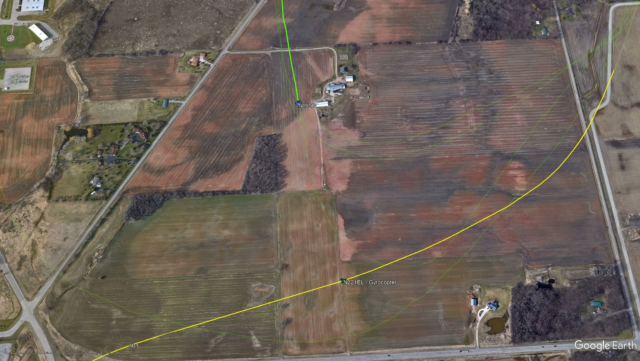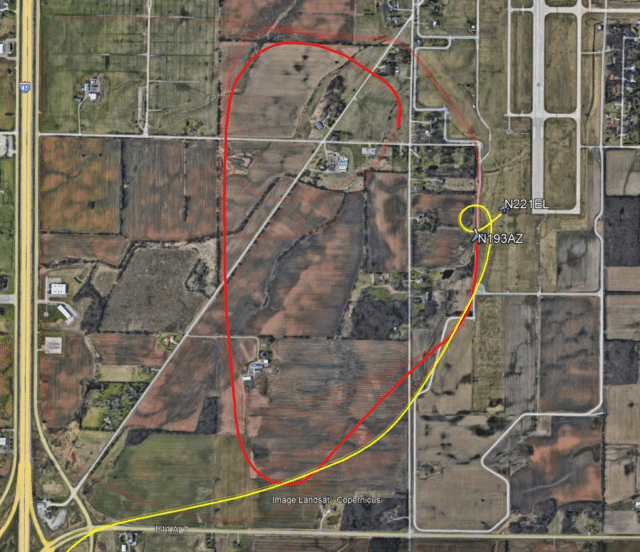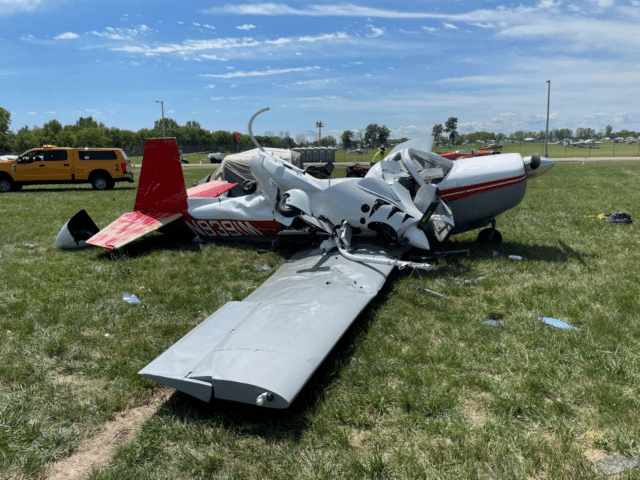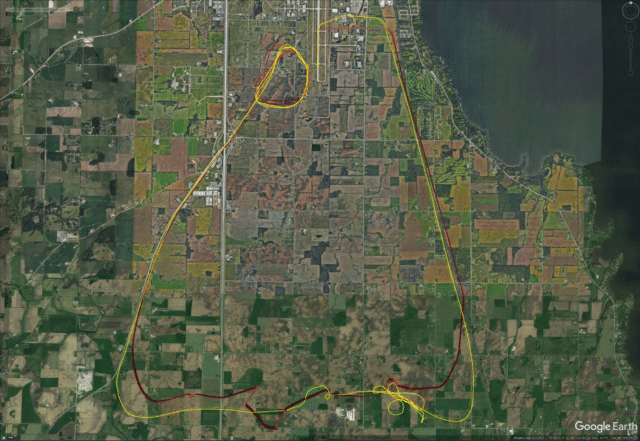A Perfect Day to Fly: The Tragic Story of the EAA AirVenture 2023 Midair Collision
In 2023, the annual EAA AirVenture airshow in Oshkosh, Wisconsin was marred by a tragic mid-air collision.
The EAA (Experimental Aircraft Association) is an aviation organisation which has hosted fly-ins since 1953. EAA AirVenture is the largest American airshow; the week-long event is held in Oshkosh, Wisconsin, every year in July.
The large number of attending aircraft and events means that the EAA requires a number of waivers to existing rules by the FAA. These are covered in a 30-page NOTAM (link goes to 2024 version) released each year by the FAA, documenting all of the show-specific guidelines and procedures during the event.
One of the highlights of the week is the Fun Fly Zone, which offers flying space for ultralights, homebuilt aircraft and rotorcraft. The FFZ airfield has a 900-foot grass runway (18/36) and a low-altitude traffic pattern, allowing for spectators to watch the demonstrations of the slower aircraft.
An airfield traffic pattern, also known as a circuit, is a standard path used by air traffic approaching the runway. A standard pattern at a general aviation airport is a loop, usually to the left, shaped a bit like a race track.

Note here the base leg, which is a common point to join the pattern ready for the turn to final approach and the runway.
At the Fun Fly Zone, there were at least two traffic patterns, a long pattern and a short pattern, which were put into effect by the air boss. The pattern at the small runway in the FFZ is low, just 300 feet above ground level, to keep the small and slow aircraft out of the way of the larger aircraft using runway 27. It isn’t quite a loop as the aircraft have to avoid various areas, including the OSH airport tower and the campsite areas.
AirVenture’s page on Ultralight/Homebuilt Rotorcraft Arrivals includes a video of the pattern (note: this video has been updated for 2024 following the accident):
In addition to this information and a briefing handout, all flying pilots must attend the daily briefings held at the Barn in the FFZ area.
On the morning of the 29th of July 2023, the briefing was held as normal.
One pilot who attended remembers a specific plea to gyroplanes.
There were several incidents during each of the daily rotorcraft flyby sessions that caused requests for the autogyro pilots to comply with traffic pattern standards. Unexpected turns, poor pattern entry/exit, and setting up for what appeared to be landing (very low and slow) only to resume flight speeds and gaining altitude quickly, all without communicating their intentions. The pilots were asked repeatedly to stop doing 360 turns and spirals while in the traffic pattern. They were also asked to stop slowing down as if to land (on the grass runway) then unexpectedly climbing back up into the traffic pattern.
Both pilots involved in the collision had attended the briefing.
The pilot and owner of the ELA Eclipse gyroplane, registered in the US as N221EL, had attended AirVenture before as a spectator. ELA Aviation USA, the manufacturer of the gyroplane, had asked him to assist visitors at their exhibit: answering questions and offering rides or demonstration flights to interested visitors. The pilot said that he had given rides to hundreds of people before as he enjoyed sharing the experience. However, this was his first time flying at an event.
The passenger had met the pilot at the exhibit booth where he added his name to a demonstration flight list. He described the weather as a beautiful day to fly; a perfect day. The pilot refueled the gyroplane and then invited the passenger to board for a local area flight.
They departed from runway 36 and flew south, then west and then north before entering the traffic pattern.
The pilot of the Rotorway 162F helicopter, registered in the US as N193AZ, had landed to drop off one passenger and pick up another. They departed from the rotorcraft take-off and landing zone and began a left circuit in the rotorcraft short traffic pattern. The passenger in the Rotorway was a also helicopter pilot who had just finished building his own helicopter but hadn’t brought it with him to Oshkosh.
The gyroplane was on the base leg, approaching the runway from the south. There were two helicopters ahead: one on the base leg and one in final approach. The Rotorway helicopter had followed the pattern and was coming in behind the gyroplane on the base leg.
A photographer on the ground was taking pictures of the various rotorcraft. He watched the first two helicopters come in low ready for landing.
The Rotorway helicopter had a GoPro camera mounted in the cockpit. The passenger pointed in the direction of the gyroplane.

The gyroplane passenger started recording a video on his phone. He remembered that the pilot started an impressive left turn. He wasn’t sure why they were turning.
The photographer saw the gyroplane make a hard 180 turn. He found it odd but assumed that the gyroplane was going around for spacing. He looked away, as nothing was landing for him to photograph at that moment.
The Rotorway turned north. It was flying straight at 77 miles per hour about 225 feet above the ground, descending at a rate of 200 feet per minute.

The cockpit video footage on the Rotorway showed the helicopter passenger flinching and the undercarriage and side of the gyroplane coming into the frame, followed by the sound of crashing.
The photographer turned at the sound and saw “pieces of an aircraft falling from the sky”.
The two aircraft hurtled towards the ground with debris flying.

The helicopter slammed onto the grass and burst into flames, killing the pilot and passenger. The last recording on the cockpit GoPro was the sound of sirens.
The gyroplane crashed into a parked plane near the road. The passenger’s leg was pinned under the unconscious pilot but he managed to get to get himself out of the crushed cockpit. Medical personnel were rapidly on the scene: both occupants were seriously injured and transported to hospital.

Afterwards, the gyroplane pilot said that as a result of his injuries, which included concussion, two brain bleeds, six broken ribs, a bruised lung and a broken nose, he remembers nothing that day after moving the gyroplane towards the runway to prepare for a personal flight.
Through others, I am aware that I made a personal flight, and was involved in the accident, at approximately 12:27 p.m. local time. However, I have no actual recollection of any of the details of the flight. The next event I can recall is waking up in the hospital the next morning.
From discussions with other pilots and YouTube videos from the event, he believes that the air boss had asked the inbound aircraft to hold up or slow down to make room for departing traffic.
Though I cannot actually recall the details of my thought process at the time, after reflecting on the matter post-accident, I believe under the circumstances which existed, I would’ve considered the idea of a “go-around” or other similar maneuver to be less safe than a left-360 for spacing.
The gyroplane pilot remembered being at the briefing but could not remember any of the details. In his statement, he made no mention of the gyroplane pilots being told to stop doing 360s in the pattern.
The GPS data recovered from the gyroplane showed that the previous day, Friday the 26th, the pilot had also performed a 360° near the northwest end of the runway. Looking at the Global Positioning Devices – Specialist’s Factual Report in the docket there were two flights that day, both with 360°s in the pattern.

One of the Fun Flying Zone volunteer staff recalled the Friday incident and said that the aircraft behind the gyroplane had complained about the manoeuvre on the radio frequency. The volunteer said that the briefing on the morning of the accident was very specific about “no 360°s in the pattern” specifically because of the close call the day before.
[The gyroplane] did a 360 despite the briefing on Saturday and the Friday close call. In the 360, he was over power lines, trees, houses, parked aircraft and people at the show: all are against the procedures outlined in the briefing.
The families of the two pilots in the Rotorway helicopter are suing the gyroplane pilot and the EAA. Their claim against the EAA contends that “the EAA cannot by law arrogate to itself the power to establish a separate ‘airport within an airport” and thus the rules were not mandatory, although the complaint agrees that these rules were made clear in the daily pilot briefings. They further allege that the EAA failed to enforce flight safety rules and failed to provide sufficient air traffic control.
The NTSB’s final report CEN23FA333, released last month, concluded that the gyroplane pilot was at fault.
The failure of the gyroplane pilot to see and avoid the helicopter while maneuvering in the traffic pattern. Contributing to the accident was the gyroplane pilot’s performance of a prohibited maneuver in the traffic pattern.
The NTSB Docket includes the witness statements and GPS data.
The EAA has made a number of changes to the FFZ procedures, including designating a sterile corridor for traffic on the base leg and standardising the traffic pattern for approach, eliminating the “short” pattern.
More importantly, they now have a one-strike rule: anyone who does not conform to the FFZ procedures will not be allowed to fly during the remainder of that year’s AirVenture.
The gyroplane pilot told the NTSB investigator that due to the chaotic nature of flying at Oshkosh during AirVenture, he would never consider doing it again.








What happened to the fourth from last paragraph?
I decided to change it and then forgot what I was doing halfway through. Fixed now, without a trace of anything wrong. (Thanks)
Next time fix it and delete my comment too!!! I’d be cool with that, just trying to help!
It’s useful! At least the link was still there but it’s good to actually finish sentences that I start. I should try that more often…
I see nothing in the report about the surviving pilot’s belief that the traffic boss had told him to make way for departing traffic. Are ATC communications generally recorded? (Officially, not just by someone listening in.) Was this one?
That was a very … convenient … concussion. The report doesn’t mention whether the passenger could heard outside communications, and if so whether he was asked what he remembered.
This column mentions the addition of a one-strike rule, applying to the rest of a given year’s meet; I wonder whether a permanent ban was discussed. I go to relatively small science fiction conventions; the larger local one has now banned-for-life about a dozen people for assorted serious misbehaviors, and I know of other conventions that have permanently banned people. Being a common idiot usually isn’t enough to get banned, but common idiocy is more likely to be fatal in the air.
There’s nothing in the report or the docket about the ATC communications so I figure they must not be — but then, they also had the GoPro in the helicopter and the passenger filming in the gyroplane, so I think if ATC had told him to make way, they’d have referenced one of those. The underlying point remains — 360° is the wrong way to achieve spacing regardless.
I don’t know if they referred to a permanent ban but I liked the fact that it would have dealt with this scenario nicely: the gyroplane pilot clearly wasn’t listening or didn’t think it applied to him. With this rule, he’d be grounded for the rest of the show and know exactly why. As it is, people seemed to talk around him not to him.
I think the SF community does get a bit up-in-arms when people get banned from conventions, with a whole round of “maybe he’s just socially inept”, and I could imagine that being even worse at Oshkosh, which is very much about private pilots getting to fly in and take part, regardless of experience level. When I was at the Air Baltic show last month, I was wishing I had a plane that I could have flown in for the show, and I can imagine that its even more of a draw at Oshkosh.
Note: earlier in the report: “descending at a rate of 200 feet per second” — per minute? (per the report you link to.)
Fixed. I’ve done that before — I th ink the ground always looks like it is coming up a lot faster than it should be.
I’m frankly both appalled and perplexed at the gyroplane pilot’s attitude toward safety in general. Even had this accident never happened (or had it been a near miss), “I’m operating in this airspace/special situation for the first time, but I’m going to disregard the instructions of much more experienced pilots about the advisability of these non-standard maneuvers” does not seem like a safety-focused decision to me.
I also hope that the EAA’s new procedures include every pilot operating in the AirVenture environment having to put ink to paper acknowledging that they’ve received, read, and will comply with the procedures in effect therein. When there are that many aircraft in such a small space, a cavalier attitude about safety just carries with it too much risk.
I think your point of “that many aircraft in such a small space” is key: it really requires an additional level of vigilance and the EAA must take the problem seriously. That said, they submitted a list of changes (and further potential changes) to the NTSB before the report was even complete and are taking that seriously.
There is a special level of hubris to making EAA your first ever fly-in and then operating there with only half an ear to the briefing. I believe this year they have also banned passengers for this type of flight.